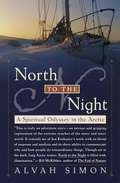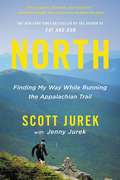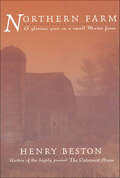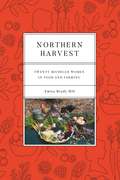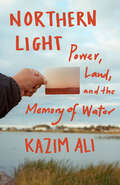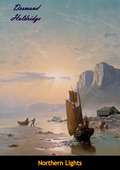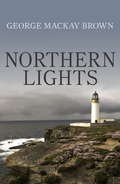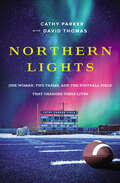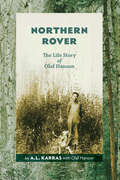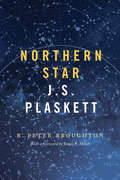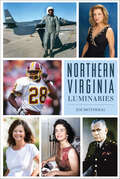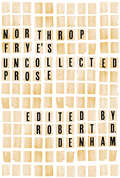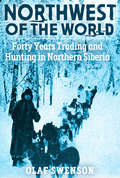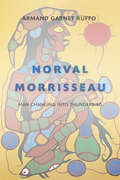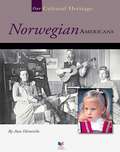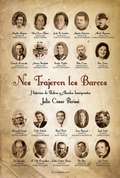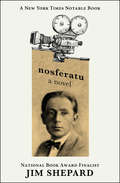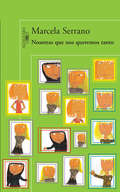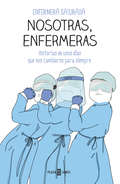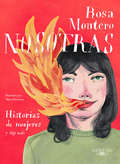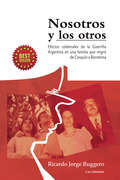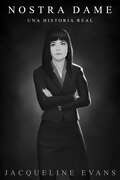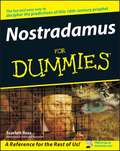- Table View
- List View
North to the Night: A Spiritual Odyssey in the Arctic
by Alvah SimonIn June 1994 Alvah Simon and his wife, Diana, set off in their 36-foot sailboat to explore the hauntingly beautiful world of icebergs, tundra, and fjords lying high above the Arctic Circle. Four months later, unexpected events would trap Simon alone on his boat, frozen in ice 100 miles from the nearest settlement, with the long polar night stretching into darkness for months to come. With his world circumscribed by screaming blizzards and marauding polar bears and his only companion a kitten named Halifax, Simon withstands months of crushing loneliness, sudden blindness, and private demons. Trapped in a boat buried beneath the drifting snow, he struggles through the perpetual darkness toward a spiritual awakening and an understanding of the forces that conspired to bring him there. He emerges five months later a transformed man. Simon's powerful, triumphant story combines the suspense of Into Thin Air with a crystalline, lyrical prose to explore the hypnotic draw of one of earth's deepest and most dangerous wildernesses.
North: Finding My Way While Running the Appalachian Trail
by Scott Jurek Jenny JurekFrom the author of the bestseller Eat and Run, a thrilling new memoir about his grueling, exhilarating, and immensely inspiring 46-day run to break the speed record for the Appalachian Trail.Scott Jurek is one of the world's best known and most beloved ultrarunners. Renowned for his remarkable endurance and speed, accomplished on a vegan diet, he's finished first in nearly all of ultrarunning's elite events over the course of his career. But after two decades of racing, training, speaking, and touring, Jurek felt an urgent need to discover something new about himself. He embarked on a wholly unique challenge, one that would force him to grow as a person and as an athlete: breaking the speed record for the Appalachian Trail. North is the story of the 2,189-mile journey that nearly shattered him.When he set out in the spring of 2015, Jurek anticipated punishing terrain, forbidding weather, and inevitable injuries. He would have to run nearly 50 miles a day, every day, for almost seven weeks. He knew he would be pushing himself to the limit, that comfort and rest would be in short supply -- but he couldn't have imagined the physical and emotional toll the trip would exact, nor the rewards it would offer.With his wife, Jenny, friends, and the kindness of strangers supporting him, Jurek ran, hiked, and stumbled his way north, one white blaze at a time. A stunning narrative of perseverance and personal transformation, North is a portrait of a man stripped bare on the most demanding and transcendent effort of his life. It will inspire runners and non-runners alike to keep striving for their personal best.
Northern Farm: A Glorious Year on a Small Maine Farm
by Henry BestonIn the tradition of his well-loved The Outermost House, Henry Beston's Northern Farm captures "the elusive magic of a year on a Kennebee farm...in truly beautiful prose" (Kirkus Reviews). Among the blue-white shadows and graceful curves of freshly fallen snow, the first rains of spring, and the quiet green of an early summer morning, Beston brings the reader into an inescapable alliance with the natural world. He translates the philosophy of the Maine farmer into terms as applicable in Manhattan as on the Kennebee. One of the great classics of American nature writing, Northern Farm is inspiring reading and ranks as one of Beston's most memorable and lyrical works.HENRY BESTON (1888-1968) was the author of many books, including The Outermost House, White Pine and Blue Water, and The St. Lawrence.
Northern Harvest: Twenty Michigan Women in Food and Farming (Painted Turtle)
by Emita Brady HillNorthern Harvest: Twenty Michigan Women in Food and Farming looks at the female culinary pioneers who have put northern Michigan on the map for food, drink, and farming. Emita Brady Hill interviews women who share their own stories of becoming the cooks, bakers, chefs, and farmers that they are today—each even sharing a delicious recipe or two. These stories are as important to tracing the gastronomic landscape in America as they are to honoring the history, agriculture, and community of Michigan. Divided into six sections, Northern Harvest celebrates very different women who converged in an important region of Michigan and helped transform it into the flourishing culinary Eden it is today. Hill speaks with orchardists and farmers about planting their own fruit trees and making the decision to transition their farms over to organic. She hears from growers who have been challenged by the northern climate and have made exclusive use of fair trade products in their business. Readers are introduced to the first-ever cheesemaker in the Leelanau area and a pastry chef who is doing it all from scratch. Readers also get a sneak peek into the origins of Traverse City institutions such as Folgarelli’s Market and Wine Shop and Trattoria Stella. Hill catches up with local cookbook authors and nationally known food writers. She interviews the founder of two historic homesteads that introduce visitors to a way of living many of us only know from history books. These oral histories allow each woman to tell her story as she chooses, in her own words, with her own emphasis, and her own discretion or indiscretions. Northern Harvest is a celebration of northern Michigan’s rich culinary tradition and the women who made it so. Hungry readers will swallow this book whole.
Northern Light: Power, Land, and the Memory of Water
by Kazim AliAuthor is an acclaimed poet with four published collections of poems, her most recent the majorly successful Oceanic; her debut nonfiction book will appeal to the massive audience she's garnered through previous publications as well as her 18K followers on social media We expect strong blurbs from acclaimed writers Kiese Laymon, Ross Gay, and Nicole Chung Cover and interior art contributed by illustrator Fumi Nakamura; interior will be published in full-color, making it a gorgeous package and perfect gift book Audiobook published and distributed in tandem with publication, read by author Book's distinct engagement with joy, nature, science, the environment, memoir, and the experiences of people of color provides opportunities for wider coverage and crossover into larger markets
Northern Lights
by Desmond HoldridgeFirst published in 1939, this is the gripping account of a voyage in a small sloop from Nova Scotia to the northern coast of Labrador…With his tiny ex-fishing boat ‘Dolphin’ pounding on the rocks in a fjord in northern Labrador in the 1920s, a young adventurer and his friends try an unusual trick in an attempt to save her.Illustrated with engravings by Edward Shenton that effectively capture the essence of their experience.
Northern Lights: A Poet's Sources
by George Mackay BrownMany of the places, people, legends and seasons that formed Brown's vision and work are presented here, with poems appearing among the prose. Included are memoirs of his parents, friends and passing strangers with legends and stories of the places.
Northern Lights: One Woman, Two Teams, and the Football Field That Changed Their Lives
by David Thomas Cathy ParkerLife is hard in Barrow, Alaska. Football mom Cathy Parker first caught a glimpse of this far-away reality from the comfort of her Jacksonville, Florida, living room while watching a 2006 ESPN report on the Barrow Whalers, a high school football team consisting mostly of Alaskan Inupiat Eskimo natives playing in the most difficult of conditions and trying to overcome the most unlikely of odds. These players—raised in the northernmost town in the United States, where drug abuse is rampant and the high school dropout rate is high—found themselves playing on a gravel field, using flour to draw the lines. And while the community of Barrow felt a strong pride for their boys, many felt football was not worth the investment. That is, until Cathy Parker became involved.Overcome by a surprising stirring in her soul to reach out and help, Cathy was determined to build a suitable field for the Barrow Whalers. Not fully understanding the many obstacles, both financially and logistically, that would line the path ahead, Cathy charged forward with a determined spirit and a heart for both the football team and the greater community of Barrow. She spearheaded a campaign that raised more than half-a-million dollars through people all around the country rallying around one common goal: changing the lives of young men through football. This is not just the story of how the Barrow Whalers became the first high school above the Arctic Circle to have a football program. This is the story of how we are sometimes called to the most unlikely of causes and to believe in something a little bit bigger, changing our own lives and the lives of others for the better in the most unexpected of ways.
Northern Rover: The Life Story of Olaf Hanson
by A. L. Karras Olaf HansonFrom 1919 to 1970, Olaf Hanson was a trapper, fur trader, prospector, game guardian, fisherman, and road blasting expert in northeastern Saskatchewan. He told his life story to popular Saskatchewan author A. L. Karras, who wrote this historical memoir in the 1980s. In an uncompromising, straightforward style, Karras and Hanson reveal the geography, wildlife, and natural history of the region as well as the business and social interactions between people. Northern Rover offers a look at the vanishing subsistence and commercial economy of the boreal forest, wound around a fascinating personal story of courage and physical stamina.
Northern Star: J.S. Plaskett
by R. Peter Broughton James E. HesserJohn Stanley Plaskett was Canada’s pre-eminent astronomer in the first half of the twentieth century. His legacy lives on in the observatory he founded in Victoria, British Columbia, and the reputation he built for Canada as a nation making vital contributions to basic science. Plaskett’s pioneering work with the most massive stars and his definitive determination of the rotation of the Milky Way Galaxy earned him international recognition of the highest order. Northern Star explores Plaskett’s unorthodox and fascinating life from his rural roots near Woodstock, Ontario through his days as a technician at the University of Toronto to his initiation in astronomy at the Dominion Observatory in Ottawa. His greatest achievements followed after he persuaded the government of Canada, in spite of the strictures of the First World War, to finance what was then the world’s largest operational telescope. Peter Broughton’s accessible and engaging prose illuminates Plaskett’s numerous achievements and the social, political, economic, and religious milieu surrounding them. This richly illustrated volume invites readers to understand the pull that Plaskett’s passions, personality, and motivations exerted on him during his lifetime.
Northern Virginia Luminaries (American Chronicles)
by Joe MotheralJournalist Joe Motheral tells the stories of prominent locals met and interviewed over the course of his long career. People from all over the US and the world move to northern Virginia to be close to the nation's capital, and many people of national importance make their home in the area. There are as many more, born and raised here, who are well known to locals. Become acquainted with a selection of iconic Virginians, with varying personalities and a variety of fulfilling lives. Read about Geraldine Brooks, Roger Mudd and General George C. Marshall, as well as local heroes.
Northrop Frye's Student Essays, 1932-1938
by Northrop Frye Robert D. Denham'Frye was a person of uncommon gifts, and very little that came from his pen is without interest.' So writes Robert Denham in his introduction to this unique collection of twenty-two papers written by Northrop Frye during his student years. Made public only after Frye's death in 1991, all but one of the essays are published here for the first time.The majority of these papers were written for courses at Emmanuel College, the theology school of Victoria College at the University of Toronto. Essays such as 'The Concept of Sacrifice,' 'The Fertility Cults,' and 'The Jewish Background of the New Testament' reveal the links between Frye's early research in theology and the form and content of his later criticism. It is clear that even as a theology student Frye's first impulse was always that of the cultural critic. The papers on Calvin, Eliot, Chaucer, Wyndham Lewis, and on the forms of prose fiction show Frye as precociously witty, rigorous, and incisive - a gifted writer who clearly found his voice before his last undergraduate year.David Lodge wrote in the New Statesman: 'There are not many critics whose twenty-year-old book reviews one can read with pleasure and instruction, but Frye is an exception to most rules.' Northrop Frye's student essays provide pleasure and instruction through their comments on the Augustinian view of history, on beauty, truth, and goodness, on literary symbolism and tradition.
Northrop Frye's Uncollected Prose
by Robert D. DenhamNorthrop Frye's Uncollected Prose, which features twenty-one pieces in the form of notes, prefaces, reviews, and talks, is the latest addition to the impressive body of writing by and about Frye. Among the highlights of the collection are Frye's "Notes on Romance," written in preparation for the lectures that eventually became The Secular Scripture; a newly discovered early notebook, parts of which may date from his second year as an undergraduate at Victoria College; and a pair of previously unavailable interviews. Expertly introduced by Robert D. Denham, one of the leading editors of Frye's papers, Northrop Frye's Uncollected Prose offers valuable insight into Frye's early life, his research methodology, and thought process, and is further proof of the remarkable depth and range of his work.
Northwest of the World: Forty Years Trading and Hunting in Northern Siberia
by Olaf SwensonNorthwest of the World, first published in 1944, is the memoir of American explorer and fur-trader Olaf Swenson (1883-1938). The book chronicles his long career in Alaska and Siberia, and provides a fascinating look into the native culture of northeastern Siberia, as well as the difficulties - extreme cold, ships frozen in ice, nearly impossible travel conditions, and Soviet officials -- faced by Swenson and his crews. Illustrated with 8 pages of photographs.
Norval Morrisseau
by Armand Garnet RuffoNorval Morrisseau (1932-2007), Ojibway shaman-artist, drew his first sketches at age six in the sand on the shores of Lake Nipigon. By the end of his tumultuous life, the prolific self-taught artist was sought by collectors and imitated by forgers. Critics, art historians and curators alike consider him one of the most innovative artists of the twentieth century. Norval Morrisseau: Man Changing Into Thunderbird is an innovative and rich biography of this charismatic and troubled figure. Drawing upon years of extensive research, including interviews with Morrisseau himself, Armand Ruffo evokes the artist's life from childhood to death, in all its vivid triumphs and tragedies. Ruffo draws upon his own Ojibway heritage and experiences to provide insight into Morrisseau's life and iconography from an Ojibway perspective. Captivating and readable, this is a brilliantly creative evocation of the art and life of Norval Morrisseau, a life indelibly tied to art.
Norwegian Americans
by Ann HeinrichsNorwegian Americans tells the story of Norwegian immigrants who came to America for opportunity while attempting to maintain their cultural ties without losing them in the New World.
Nos trajeron los barcos: Historias de padres y abuelos inmigrantes
by Julio Cesar ParissiVeinte personalidades de la cultura argentina cuentan sus historias deinmigración. Que la Argentina es un crisol de razas lo aprendimos en el colegio. Quecasi todos tenemos algún antepasado español, italiano, sirio, armenio,ruso, no es ninguna novedad. Pero es justamente esta característica laque nos une y logra que nuestras historias tengan puntos en común. Poreso, Julio Parissi entrevistó a veinte importantes personalidades de lacultura argentina para que cuenten sus historias de inmigración: Sarah yJoel, los padres de Cipe Lincovsky que escaparon desde Lituania paraasentarse en la zona del Abasto; o Agustín y Josefa, dos vascosemprendedores, abuelos de Juan Sasturain; o Antonio, el abuelo deEnrique Pinti que trajo su biblioteca desde un pueblito italiano, enplena década infame. Estas son solo algunas de las veinte historias conlas que todos nos sentiremos, inevitablemente, identificados.
Nosferatu: A Novel
by Jim ShepardA New York Times Notable Book:The richly imagined fictional life of one of cinema&’s founding fathers from National Book Award finalist Jim Shepard In 1907, while waiting for a train that would take him from his quiet rural hometown to university in cosmopolitan Berlin, Friedrich Wilhelm Plumpe met Hans Ehrenbaum-Degele, the great passion of his life. Hans was the catalyst for Plumpe&’s transformation into F. W. Murnau, the filmmaker best known for directing Nosferatu—the iconic silent film adaption of Bram Stoker&’s Dracula—as well as The Last Laugh, Sunrise, and Tabu. As we follow Murnau from the airfields of the Great War to the cafés and clubs of Weimar Berlin to the virtual invention of filmmaking, and from there to the South Seas, we chart the progress of a man desperate to open himself to others but nonetheless continually &“at home in no house and in no country.&” While devoted to those he loved, Murnau remained hamstrung by self-loathing and, like his vampiric creation, afraid of his own &“terrible inhumanness.&” In his fascinating fictionalized biography of Murnau, Jim Shepard, author of the critically acclaimed The Book of Aron, brings both Weimar-era Germany and the early days of film to life in roaring, irresistible detail, delving into the heart and mind of a troubled genius and uncovering the inner turmoil of a reclusive and enigmatic cinema pioneer.
Nosotras que nos queremos tanto
by Marcela SerranoCuatro mujeres chilenas, a las puertas de la madurez y orillas de un lago, dan curso sin inhibiciones al relato apasionado de sus historias personales. Son vidas marcadas a fuego por la experiencia socialista de Allende y el golpe militar de 1973, pero también por la huella más íntima del amor y el dolor, el desengaño y la compasión. La narradora entrelaza los hilos de estas biografías con las de otras mujeres -amigas, hermanas-, planteando página a página los dilemas de la libertad y la sumisión, la infidelidad y el matrimonio, el trabajo y el sexo. Cuando a pocos años del fin de siglo -apagados el fragor de las utopías y la explosión del feminismo- se propone que tal vez las mujeres y los hombres provengan de «planetas» diferentes. Nosotras que nos queremos tanto ilumina la relación hombre/mujer desde una óptica femenina inédita. Sea o no esta novela el retrato en clase de un sector de la sociedad chilena y sus vicisitudes de los últimos treinta años, su lectura nos enfrenta sin concesiones a los claroscuros de la condición existencial de la mujer.
Nosotras que nos queremos tanto
by Marcela SerranoCuatro mujeres chilenas, a las puertas de la madurez y a orillas de un lago, dan curso sin inhibiciones al relato apasionado de sus historias personales.Vidas marcadas a fuego por la experiencia socialista durante el gobierno de Salvador Allende y el golpe militar de 1973, pero también por la huella más íntima del amor y del dolor, el desengaño y la compasión. Los hilos de estas biografías están entrelazados con las vidas de otras mujeres "amigas, primas, hermanas", planteando página a página los dilemas de la sumisión, la infidelidad y el matrimonio, el trabajo y el sexo.Cuando a pocos años del fin de siglo -apagados el fragor de las utopías y la explosión del feminismo- se propone que tal vez los hombres y las mujeres vivan un profundo desencuentro, Marcela Serrano ilumina su relación desde una óptica femenina inédita y enfrenta sin concesiones los claroscuros de la condición existencial de la mujer.
Nosotras, enfermeras: Historias de unos días que nos cambiaron para siempre
by Enfermera SaturadaEl testimonio de cómo las enfermeras vivimos los días en que un virus paralizó el mundo en poco más de tres meses y sumió a España en la peor pandemia del siglo XXI. Esta es la historia de una enfermera que luchó contra el coronavirus en primera línea, armada con una bolsa de basura y una mascarilla reutilizada. Pero, en realidad, es también la de todos los enfermeros y las enfermeras que plantaron cara al virus, esos a los que la sociedad llamó héroes, y por quienes aplaudía a las ocho, mientras ellos y ellas vivían con el miedo pegado a su espalda. Es el testimonio de sus lágrimas, temores y sacrificios, y a la vez de la inmensa felicidad que sentían cada vez que apagaban un respirador y entregaban el alta a un paciente. «El primer paciente que atendí con la COVID-19 fue el 5 de marzo de 2020. Creo que esta será una de las fechas que recordaré toda la vida. Hasta ese día, hasta el mismo instante en que tienes frente a ti a una persona contagiada con el virus que está causando tantos estragos, mis compañeras y yo seguíamos pensando que no nos tocaría. Supongo que una, como mecanismo de defensa, tiende a negar la realidad hasta que la tiene a dos metros de distancia y con un informe del laboratorio con la palabra POSITIVO escrita en mayúsculas. A pesar de todo, y aunque los casos en Italia se contaban ya por miles, seguíamos aferrándonos al hecho de que ese día en nuestro país los confirmados apenas superaban los doscientos y en las plantas de mi hospital los casos no llegaban ni a media docena. No podíamos ni imaginar que acabaríamos ingresando, únicamente en nuestra unidad, a más de trescientos pacientes en solo dos meses. Que en toda España habría más de doscientos cincuenta mil casos confirmados, que en apenas tres meses más de cincuenta mil compañeros y compañeras se contagiarían o que nos dejarían para siempre más de veintiocho mil personas según los datos oficiales. Con este libro pretendo plasmar, de la forma más fiel posible a la realidad, todas las historias acontecidas durante estos meses para que, a pesar del paso de los años, no se pierdan en el olvido, se reescriban o se desdibujen. Así, quienes no lo han vivido tan de cerca, podrán ser más conscientes de lo que sucedió.» «La crónica de un enorme esfuerzo profesional, escrita desde la solidaridad y la angustia. Leerlo es un acto de gratitud». PEPA FERNÁNDEZ.RNE
Nosotras. Historias de mujeres y algo más
by Rosa MonteroEdición especial de uno de los libros fundamentales de Rosa Montero, Premio Nacional de las Letras 2017. Una obra pionera en la reivindicación del papel de la mujer en la historia a través de las biografías de sus protagonistas. Ilustrada por María Herreros. Escúchalo ahora «Este libro no es un libro solo para mujeres, de la misma manera que el feminismo no es solo cosa de chicas. Estamos cambiando el mundo, estamos destruyendo estereotipos milenarios, y es evidente que si se altera el papel social femenino, es porque también muda el papel de los hombres. »Incluye el texto original de Historias de mujeres, publicado hace veinticuatro años, y añade noventa nuevos pequeños retratos, una ojeada rápida desde la antigüedad hasta nuestros días que nos permite atisbar la compleja riqueza de la aportación femenina a la vida común. Porque hay una historia que no está enla historia y que solo se puede rescatar aguzando el oído y escuchando el susurro de las mujeres. La porción invisible del iceberg de protagonistas silenciadas empieza a emerger ahora, y tiene unas dimensiones colosales. Ha habido mujeres en todas las épocas haciendo cosas memorables. No hay un solo campo social, artístico o del conocimiento en el que no hayamos destacado. Y se trata de un pasado que nos han robado a todos. »Pero tenemos que hacer algo más que cambiar la visión del pasado: es esencial que también cambiemos la visión del presente. La manera en que nos miramos a nosotras mismas. El mundo, nos decían y nos decíamos, es así. Pero no. Resulta que el mundo no es así. El futuro está aquí, el futuro es hoy y lo estamos construyendo hombres y mujeres. Por primera vez estamos todos. Aunque, para ello, también debamos abandonar nosotras muchos prejuicios sexistas. Así es que, hermanas, abramos nuestras fauces de dragonas y escupamos fuego.»Rosa Montero --------------------------------- La crítica ha dicho sobre Historias de mujeres...«Escribe con el punto casi exacto de acercamiento, con sinceridad y ardor pero sin concesiones fáciles, sabedora de que sus heroínas sufrieron a causa del entorno todo, y no solo de los hombres. Desde esta óptica madura y razonable, la prosa de Montero se nos hace así paradójicamente intensa, creíble, verdadera.»Miguel Dalmau, La Vanguardia «No perseguía un documento de hazañas femeninas ejemplares, solo ejemplos de mujeres que se atrevieron a traicionar las expectativas que la sociedad, durante siglos, depositó en ellas y asaltaron con audacias inéditas los preceptos que asignaban sus funciones.»Pilar Castro, ABC «El deseo de equilibrio entre los sexos late como un pulso en todo el libro de Montero. El mismo deseo que anima los modos de sentir y pensar de una mujer que ansía, en cada lugar, por oscuro y difícil que sea, ver llegar el fin de la prohibición, el día en que cada una pueda modelar su propia forma como un regalo que no temerá.»Teresa Hernández, Diario 16 Andalucía «Una parte de la historia clandestina de las mujeres y sus esfuerzos, muchas veces trágicos, para liberarse de la norma social masculina.»Andrés Fernández Rubio, El País «Interesante muestra, no solo de lo que el género biográfico puede dar de sí abordado con pasión y oficio, también de lo que las mujeres han aportado a la historia o a sus recovecos desde el matrimonio o la rebeldía.»Care Santos, El Cultural «Mujeres que dejaron huella, que hicieron historia. [...] Mujeres con vida propia.»El Tiempo «Queda claro que Rosa Montero, como ella misma resalta, no ha pretendido sublimar la figura de la mujer, ni exaltar a heroínas o señalar víctimas y victimarios, sino mostrar "la humanidad cabal y plena, con todas sus luces y sus sombras", demuj
Nosotros y los otros: Efectos colaterales de la Guerrilla Argentina en una familia que migró de Cosquí
by Ricardo Jorge RuggeroEfectos colaterales de la guerrilla argentina en una familia que migró de Cosquín a Barcelona. Es nuestra historia, contada desde mi óptica, desde mis vivencias y desde mis sentimientos, encontrarán una sucesión de hechos políticos, religiosos y familiares que voy narrando. Algunos, como preludio de circunstancias que nos fueron afectando directa o indirectamente, y otros, vividos como protagonistas. A lo largo de estas páginas, podrá comprobarse que las opciones de vida siempre estuvieron inspiradas y alimentadas por la utopía de un mundo mejor. Muchos, imbuidos de una concepción cristiana de amor al prójimo; otros, no; pero todos lo hicieron por la justicia, la dignidad, el respeto a las ideas, el derecho a tener derechos. Y, en esa lucha, algunos pagaron con sus vidas, condenados por ser y pensar diferente a los intereses del poder de la dictadura que bañó de sangre el suelo argentino.
Nostra Dame: Una historia real
by Jacqueline EvansDescubre la verdadera historia de una mujer que intenta dar sentido a un mundo misterioso. Reprimí lo que me vino de forma natural en mis primeros años, pero un momento crucial a mediados de mis veinte abrió una puerta a lo que yacía dormido. La profundidad del conocimiento que siguió comenzó a crecer como una bola de nieve, lo que me llevó a predecir eventos globales e investigaciones de asesinatos de alto perfil. Cada pieza de información impartida en fractales, como piezas de un rompecabezas. Y dependía de mí juntar las piezas.
Nostradamus For Dummies
by Scarlett RossNostradamus made simple-a surefire prophecy of success! Michel Notredame, or Nostradamus (1503-1566), was a French physician, astrologer, and prophet whose books of visionary four-line verses have intrigued and beguiled readers for hundreds of years. Now, with this fun and easy guide, everyone can finally get a handle on Nostradamus and his "Centuries" of prophecies, which many people believe to have predicted the French Revolution, the rise of Hitler, the Kennedy assassination, and 9/11, among other events. The book covers Nostradamus's life and beliefs, his use of cryptic language and anagrams, interpretations of his work that link it to specific historical incidents, and critics who are skeptical of his prophecies. It also explores the implications of his work on the past, present, and future, and much more!
